Everybody has a preconceived notion of the shortcomings of a Reliant three-wheeler – but how does that pub wisdom compare with the reality?
Images: Simon Goldsworthy
The Reliant Regal, thanks in part of course to Only Fools and Horses with their infamous Reliant Regal Supervan III, is such a recognisable shape that you cannot approach one without all sorts of pre-conceived notions. So the hardest thing is to stop, look on it as a car like any other that is designed to do a job, and assess it on how well it does that job. Obviously it is not quite like any other car, but my point is that it really helps if you can approach it with an open mind.
However open your mind might be though, there is no getting away from the unusual three-wheeled configuration, with a single wheel up front and a more conventional layout at the back. Others did something similar in the past, perhaps most notably Bond with their Minicar, but any manufacturer of three-wheelers with sporting ambitions opted for the reverse layout with two wheels at the front and only one at the back. When pushed to the limit that is arguably a far more stable arrangement, but Reliant’s origins lay in delivery vans derived from motorbikes, which meant a motorbike-style front end mated to a pair of rear wheels to create a load bed.
That layout was then carried through to the four-seat saloon introduced in 1952 and called the Reliant Regal. This had aluminium body panels on a hardwood frame, but more and more fibreglass was introduced as the model was developed through to the MkVI. When the new Regal 3/25 arrived in 1962 it not only had an all-fibreglass body that we generally recognise as the Regal today, but also a new OHV all-alloy engine of 598cc and 25hp, designed and built by Reliant.
The 3/25 was restyled by Ogle in 1965 and became the Regal 3.25 Super. That was essentially the shape we have here on this 1968 model, but in 1967 it had become the de-Luxe to bring attention to the fact that power had been boosted from 24.2bhp to 26bhp. The final change was in August 1968 when the engine was enlarged to 701cc to create the 3/30 with 29.5bhp, the name referring to three wheels and approximately 30bhp. It was replaced by the new Reliant Robin in October 1973.
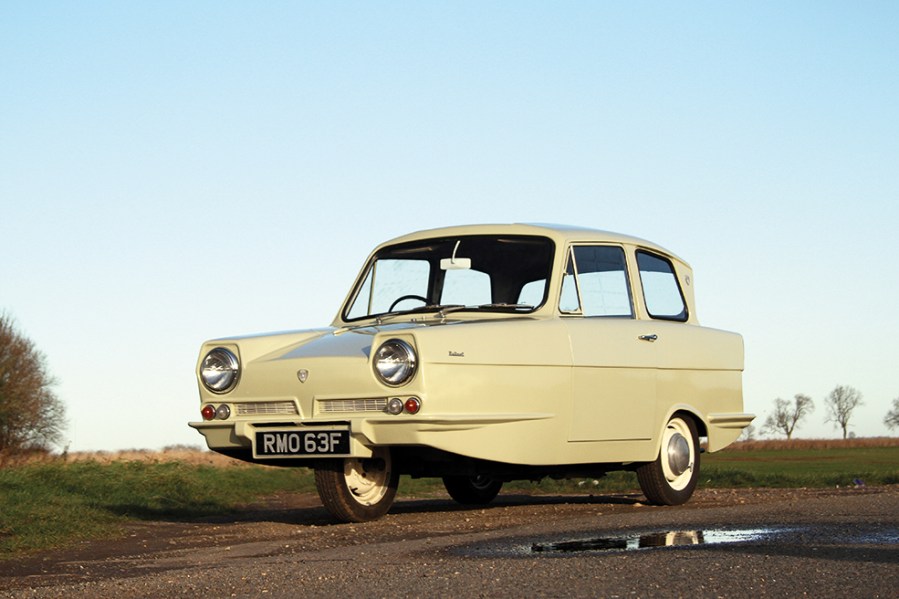
It is small, but very definitely a proper four-seater saloon car. That single front wheel does impose some design constraints though, as there is no getting away from the fact that the front appears to be floating somewhat. Somebody who was involved in design with Reliant did once tell me that one of the main objectives was to ensure that their three-wheelers did not look like whistles!
That was actually more of a problem on the later Reliant Robins, because the Regal has dummy wings on either side that suggest they are each covering a wheel. That does lead to something of a disconnect between your eyes and your brain because there are no wheels visible, but the high wings leading your eye to the headlamps recessed into the front ends do ape a four-wheel car reasonably well.
Things are much more conventional at the back, with big 12in wheels exactly where you would expect to see them. (Big for such a small car, at any rate.) The arches are quite low down and cover the tops of the wheels, which helps to bring the body line down there and partially minimise the oddness of having no front arches to match.
Move round the back and you have the same built-in strakes where the bumper wraps around the sides of the body. There is a proper boot, and a decent size too despite the fuel tank being tucked upright in the nearside rear wing. The spare wheel sits flat in the floor, and would benefit from a cover to separate it from any luggage. That luggage has to be lifted over a relatively tall rear panel, which is thin enough to get damaged if you rest heavy objects there on there way into or out of storage. Earlier Reliant designs had a boot lid that extended down to bumper level, which was more practical.
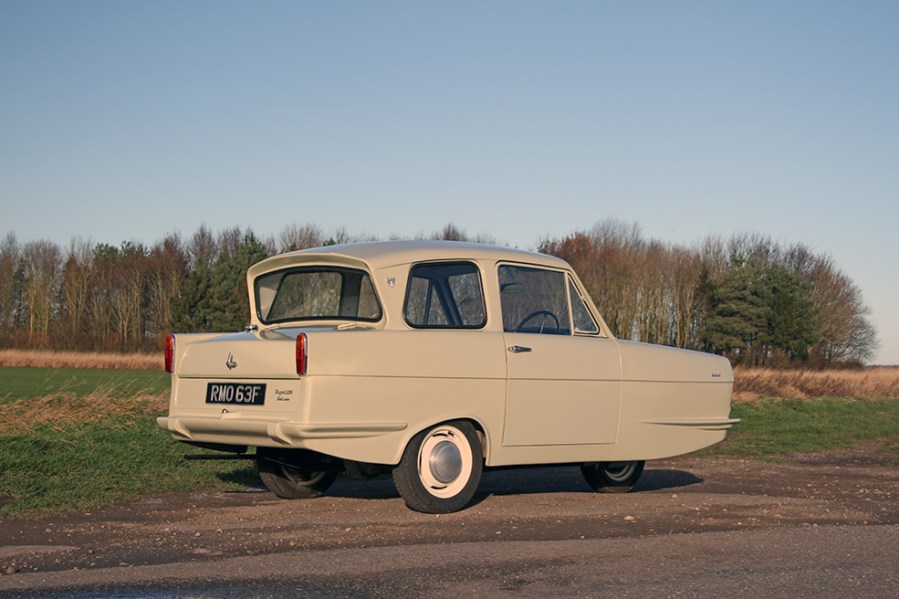
The car is of its era so there is not too much blending in of smaller items – the boot handle sticks out quite a way, the boot lid hinges are external, the badges are 3D metal scripts and there is a fuel filler pipe sticking up through the panel behind that rear screen, but none of that would have seemed unusual to buyers of an economy car in the 1960s. It is not particularly streamlined, but to my mind very stylish.
The bumpers are moulded in as part of the fibreglass body, so the style is there but actual protection is pretty limited. Continuing my walk around the car, for the restyle that created the 3/25 those bumpers were extended around the sides of the car both front and rear. The front ones reach back almost as far as the doors; this not only added Dan Dare style speed strakes, but it also strengthened the wing panels considerably.
Looking at the Reliant Regal in profile, if you cover the lower part with your hand then it does look remarkably like a Ford Anglia 105E. Clearly the reverse rake rear screen plays a big part in this resemblance, but there is more to it than that because the overall proportions and the small rear fins add to the impression. Typical of the era there is lots of glass and very slim pillars, with no obvious blind spots.
Getting back to the front end, the bonnet slopes down markedly between the high-set wings, although there is only a smaller opening panel set well back towards the windscreen. In fact there is no point having a bigger opening here because the engine is set so far back to make room for the front wheel that it intrudes into the cabin, and opening the bonnet reveals mainly the heater, radiator and battery along with only the very front of the engine. At least on the Reliant Regal there are three removable access panels in the bodywork inside the car that covers the engine between the front seats, a very useful feature that was deleted on the later Robins.
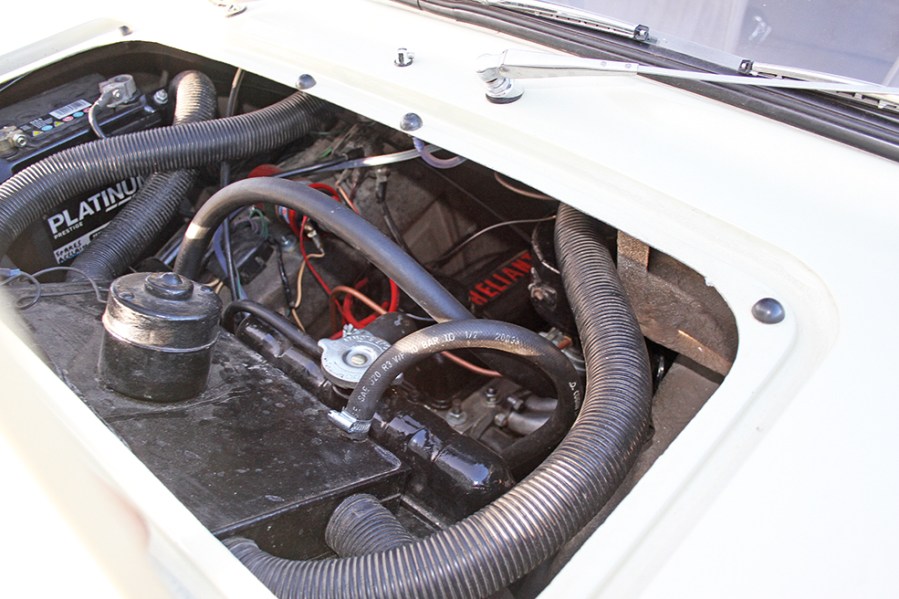
The Reliant Regal’s doors are generous so getting into the front seats is easy enough. The backrests don’t lift into position, so simply fold forwards to provide access to the rear seat, which is best limited to children. The first impression as you sit behind the wheel is that the seats are very small, narrow and with no bucket shaping at all.
There is a bit of a curve to the seat base that pushes you to the back of the cushion, but because there is also a gap between this and the seat back, you can’t put anything like sunglasses or a map on the passenger seat because that simply slides down through the gap and into the rear footwell. The backrest is very low, its top ending well below the bottom of the windows, presumably in part to save weight. The frame is lightweight aluminium tubing, and I can feel the top rail through my back, suggesting that it could do with a little more padding.
Once settled into position, you sit quite low in the Reliant Regal, meaning there is plenty of headroom and a feeling of space. Well, space on the top half at least with good vision out helping in that regard. The C-pillars do have triangular sections, but there is so much glass everywhere else that they barely impact on visibility in that direction.
The engine intrudes so much into the cabin that your legs are channelled into a narrow footwell. It is narrower on the passenger side, but the driver does at least get room for three conventional pedals as well as space to the left to rest a foot or activate the floor-mounted dip switch (remember those?). It is only the constant pressure of the side of the footwell against my left leg to remind me that it is a narrow space.
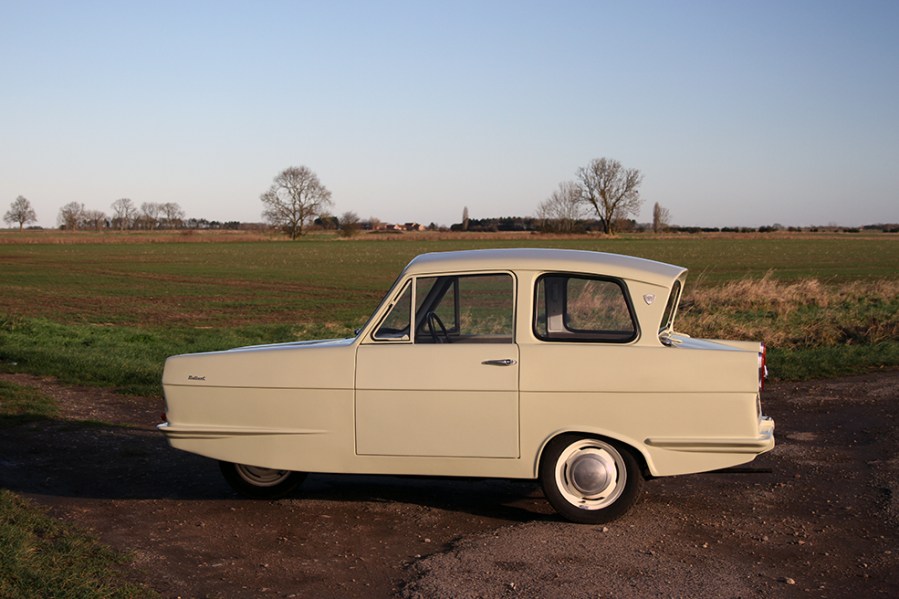
Ahead of me is a big, plain wheel through which you view a lovely half-moon instrument pod set into a dash trimmed with some totally period fake wood. There is a speedo that reads up to 80mph (in your dreams!), temperature on the right and fuel on the left, plus warning lights for ignition, oil, indicators and high beam spread around the curve. Of these, the indicator tell-tales and the high beam warning light are slightly obscured by the peak of the dash, so ideally I would have had them positioned lower down.
For storage, the Reliant Regal features large and handy storage bins on the doors, plus a cubby hole on the left rather than a glovebox as such because there is no lid. All the dash is part of the body moulding, with black vinyl across the top and the fake wood to decorate the middle, everything else being left in grey gel coat rather than being painted body colour.
As far as controls go, the centre section has the choke on the far left and ignition key on the right, with an alloy plate sandwiched between them with toggle switches for lights, wipers and heater fan, plus a manual plunger for the screenwash. They are all nicely labelled, but with no illumination so at night you have to remember where each one is. The only other control is a long and spindly indicator stalk coming out from the dash to the right of the wheel. There is a heater, but no cabin controls for it; instead you have to reach in through the bonnet to open or close a brass tap.
There are seatbelts fitted, but their anchor points are quite low to secure into the steel chassis, a natural consequence of the Reliant’s fibreglass upper structure being relatively weak. For that reason I have fitted static seat belts of the correct period, because later inertia reel ones would tend to pull down uncomfortably on your shoulder on a run and leave you with an ache. Talking of a long run, let’s get going.
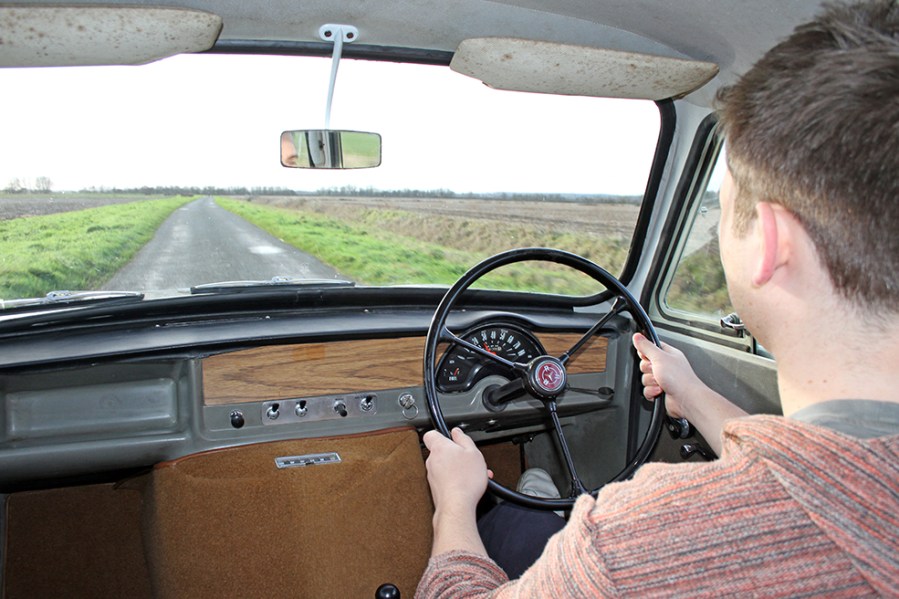
On the road
The Reliant Regal’s engine has been fully rebuilt and fires up straight away. It is not quiet, but then I haven’t fitted much in the way of soundproofing. There are four forward speeds, selected via a regular H-pattern with reverse being through a lift-up detente and next to first. That first gear is straight cut, so I tend to slip the gearstick back into synchromesh second and then forwards into first before moving off, particularly when the choke is out and the engine revving at a fast idle.
The clutch on this is sharp as a button, either on or off and taking plenty of feathering to make a smooth getaway. The gear stick is as basic as they come – a straight metal rod with a plastic ball on the end – but it goes straight into the gearbox below so the linkage is direct and the action nice and direct. There is no spring loading and a fairly long throw front to back, but nothing excessive.
First gear is extremely low, as would be required when trying to move off from rest on a hill with a full complement of passengers and luggage. When travelling solo in Lincolnshire I could probably dispense with it altogether, but it feels kinder on the car to at least get it rolling before reaching for second. Pullin out of my drive and turning right, I’m into second before I have fully crossed the white line in the centre of the road and before the speedo has really been able to register anything. Third comes in at 15mph, fourth at 25mph.
As ever, all of those figures can be upped a fair bit if you are pressing on, but maybe not by as much as you might expect because it does seem to whip up through the revs very quickly. Pulling away hard you can take it up to 40mph in third, but it does sound as though you are whipping it along slightly mercilessly. Get out on the open road and you can take fourth will take you happily up to a genuine 50-55mph. Again it will do more, but that really sounds to me like a comfortable maximum. At such speeds is tracks nice and true, but it is clearly not built for comfort because on springing that is hard enough to cope with a fully laden car does leave such a light vehicle bouncing about when there is only one body on board.
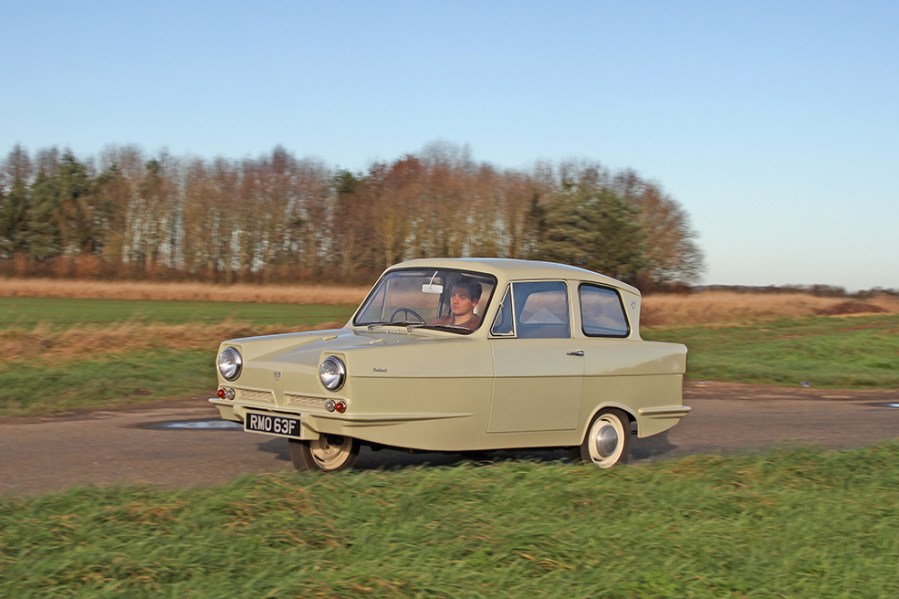
The clutch and brake pedals sprout from the floor rather than being hung from above, but the action feels natural enough. As I approach a roundabout, pushing on the brakes reveals a nicely progressive pedal that scrubs off speed smoothly and under total control, never causing the Regal to deviate from ta straight line. This actually feels better than many unservoed drum brake systems in that there is no dead spot to start with that can catch out the unwary.
All of that is very reassuring, but it brings us back to where I started this piece and the need to clear your mind of any preconceived notions. Unable to do this entirely, I find myself lifting off for roundabouts more than I would in a four-wheeler.
Travelling on a fast 60mph relief road interspersed with roundabouts you can nip through at quite a pace. It doesn’t feel to me that the Reliant Regal has any problem dynamically with taking those at a normal speed and the any body roll is unobtrusive, but I am always conscious of the fact that there are only three contact patches between me and the tarmac.
The steering is lovely and light. There is a steering box and I had wondered if having all the front end weight over the single steered wheel would make it heavy, but here that single contact patch comes into its own and it is as light as the proverbial feather.

It is pretty direct too, the absence of a separate idler arm and additional joints in the linkage no doubt helping in that regard. There is a little free play, but not much because you only have half as many balljoints, and the car does track nice and true.
The three-wheeled layout does have its own issues though, notably that with three tracks it can be harder to avoid all potholes. Even worse in on muddy or snowy roads where you get a build-up of much and slush down the centre of the lane, exactly where your front wheel needs to go.
Travelling as we are today in Lincolnshire, there are still a few hills to tackle. One particular spot on my usual test route involves exiting a village via a sharp 90° bend that leads directly into a steep hill. I have previously noticed how a long, comparatively gentle hill when you are cruising can slowly scrub off speed until you realise belatedly that you need to change down into third. This time I know what to expect, however.
Reliant Regal: our verdict
I am cruising through the village at 30mph in fourth as I approach the bend, so I drop into third and resist the temptation to over-compensate for the bend ahead and lift off the throttle. Instead I keep my foot on the accelerator and the little Regal whips round the bend without hesitation and attacks the hill with gusto.
I almost feel that it is breathing a sigh of relief that I have finally stopped pussy-footing about and decided to trust its abilities. There is a fine line between brave and stupid, or so they say. There is probably an equally fine line between confidence and over-confidence, but I think it is fair to say that, given all the mental baggage that comes with driving a three-wheeler, the Regal can comfortably exceed your expectations.
















